How To Build A Trophy Truck
Editor's Update June 2022: Every bit function of Off Route Xtreme'southward super popular PreRunner Building article series, we wanted to link the collection hither for your convenience. You tin can find all the manufactures linked as part of this update. PreRunner Edifice 101: The Nuts, PreRunner Building 102: Beginner Vs. Avant-garde, PreRunner Building 103: Testing And Tuning, and PreRunner Building 104: What Is An Ultimate PreRunner?
The prerunner truck is a popular build style. If done right, they await beautiful, and deliver astounding performance. If you've always built i, then you sympathize the complexity involved when you take a vehicle so far from what it once was. For those of you lot who have non, but would like to, this article will give you some insight into the development of a prerunner build. Information technology will be the first of a series going over the who, what, where, when, why, and how of prerunners.
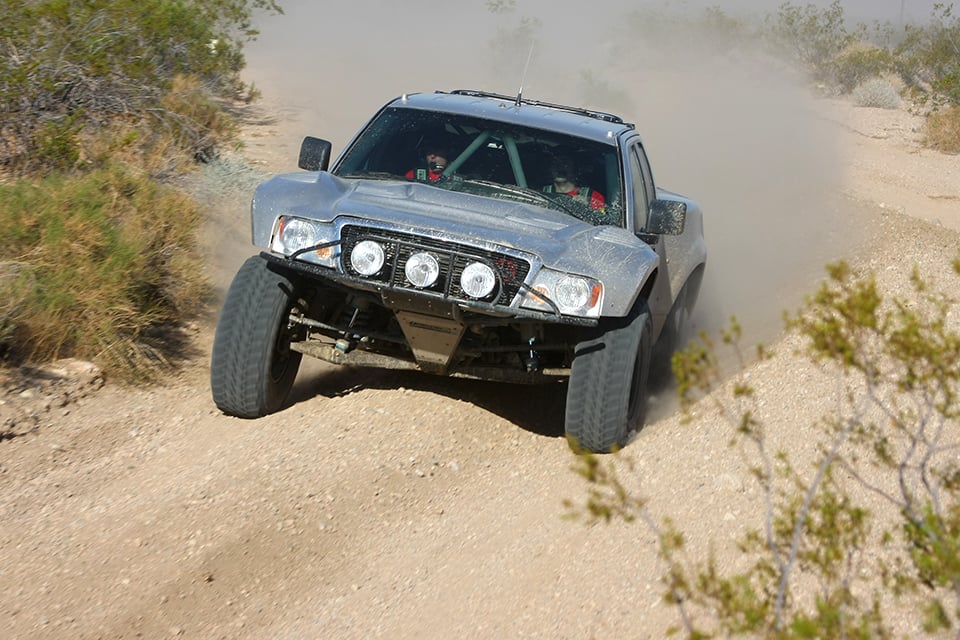
What management should y'all take on a prerunner build? Our guide will help point the way.
The first thing you need to do is come up with a program. The end upshot will usually stray from your original intent, but if you don't have an initial programme, you cannot budget time or money accurately. The easiest thing to practice is go down to your local fab shop, write a check with many zeros, and hope to have your ride in six months to a year or more.
Since near of u.s. can't do that, it's ameliorate to sit down down and figure out exactly what you want to achieve. Do you want a street truck that just looks cool? Practise you want a truck capable of merely driving around in the desert? Or practise you desire a vehicle that is capable of prerunning the Baja peninsula at race speeds for an entire season?
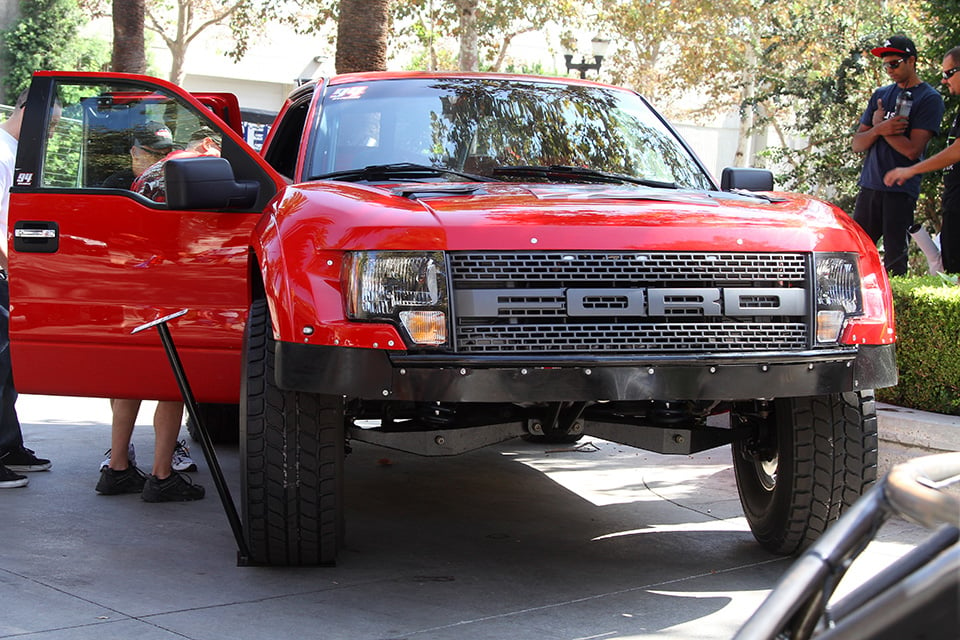
Steve Strobel'due south Raptor prerunner is nearly a Trophy Truck with opening doors.
Planning Out The Prerunner
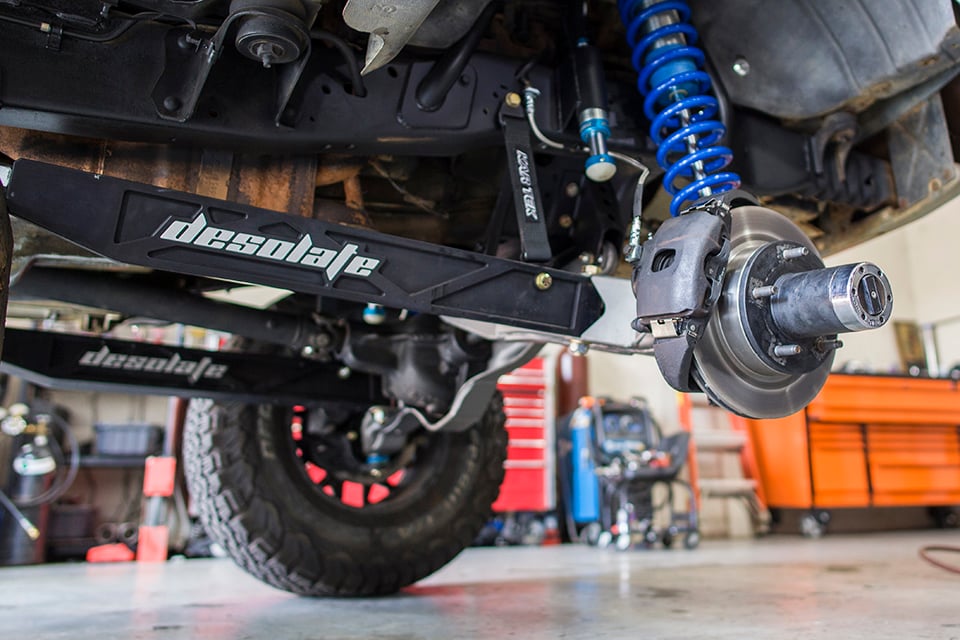
Billet radius artillery might not be absolutely vital, but they sure await awesome!
You accept to inquire yourself whether y'all have the time and coin to keep your project to completion. Practise y'all take a space to piece of work? Practise you take tools, and the skills to use them? Are y'all going to bulldoze your vehicle during the process, or do a complete build from the ground up?
Many projects are started, merely stall out considering they were not properly planned out from the outset. Once you evaluate your wants and needs, your goals may change.
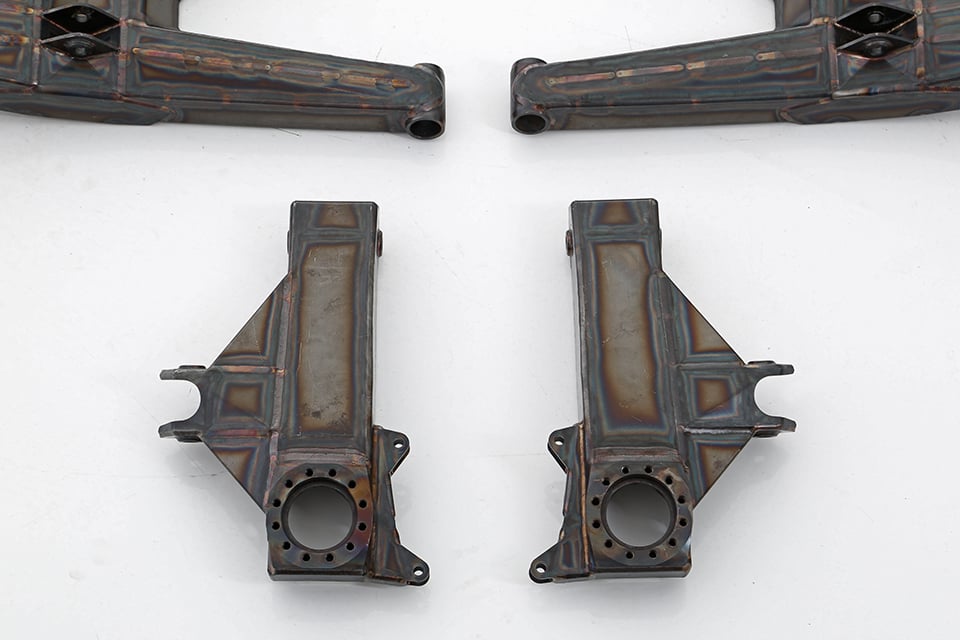
Many bolt on kits are constructed using race quality materials and fabrication methods.
You might be just as happy with a leveling kit, wheels, and tires. There is a lot to be said for the people smart enough to do a mild build, and enjoy it, instead of spending years dropping money into a garage trophy.
Another reason to make a plan relates to the best advice you will e'er get about building any automotive project; do information technology correct the commencement time. Most temporary fixes are just apparently wasted money. If you have to do something over, y'all are nevertheless paying the money you thought yous couldn't beget, and the money you lot laid out when you went for the quick fix. That adds on a lot of price that can exist used to amend advantage somewhere else.
Part of your program must include what type of vehicle you want to build. Are you looking for a full-size truck, midsize, or something altogether different. A pop tendency correct now is to outfit road-going cars or SUVs with big tires, shocks, and a few off-route accessories, and then hitting the dirt. They don't have nearly the capabilities of a long-travel prerunner, but information technology might but fit your needs.
2WD Or 4WD? You Decide
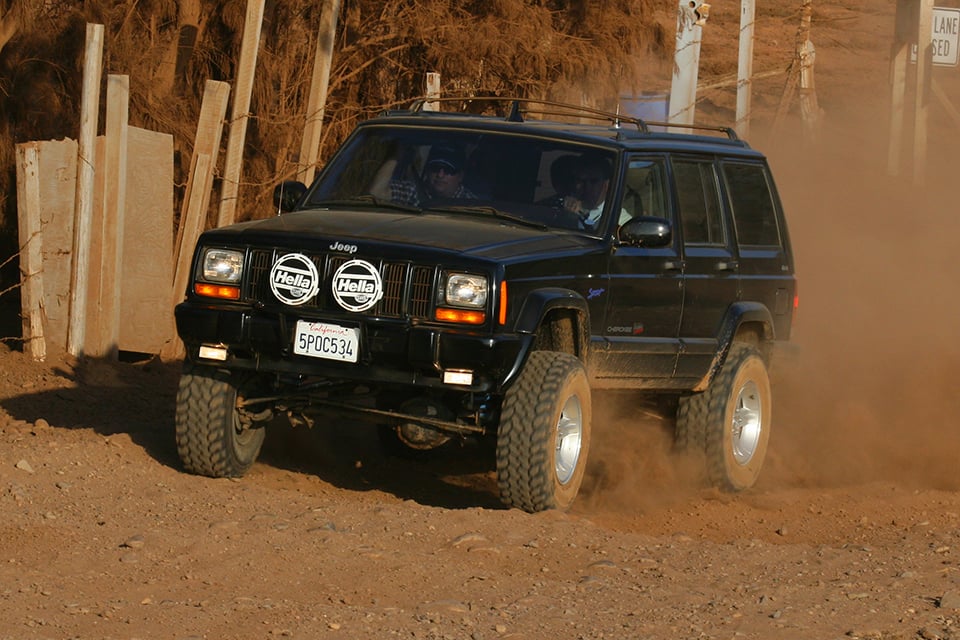
A Jeep Cherokee 4WD with basic mods prerunning in Mexico.
One of the biggest factors in deciding what to start with is the question of two- or four-bicycle-bulldoze. Four-wheel-drive is a real luxury. When information technology comes to traversing all types of terrain with little drama, four-bicycle-drive takes the cake. Edifice a two-wheel-drive prerunner nearly locks you lot into building something highly modified considering you will be running at higher speeds, and putting more than of a strain on the components. When you dull down or stop in 2WD, you are e'er at chance of getting stuck. When speed is your only friend, you will use all the bicycle travel and traction you lot can muster. That means you will need beefier intermission and driveline components.
What 2WD does practice meliorate at than 4WD is saving weight and having far fewer moving parts. More often than not, you are able to get much more cycle travel out of a 2WD suspension than a 4WD, because 4WD joint depends on the maximum angle y'all can put on the CVs or U-joints on the front axle shafts. If your goal is to practice actual prerunning, 2WD will exist fine, because you will be running at high speeds most of the time. You can drive through but well-nigh anything at speed; but if you lot programme on stopping in the silt, mud, or sand, you will need a good shovel.
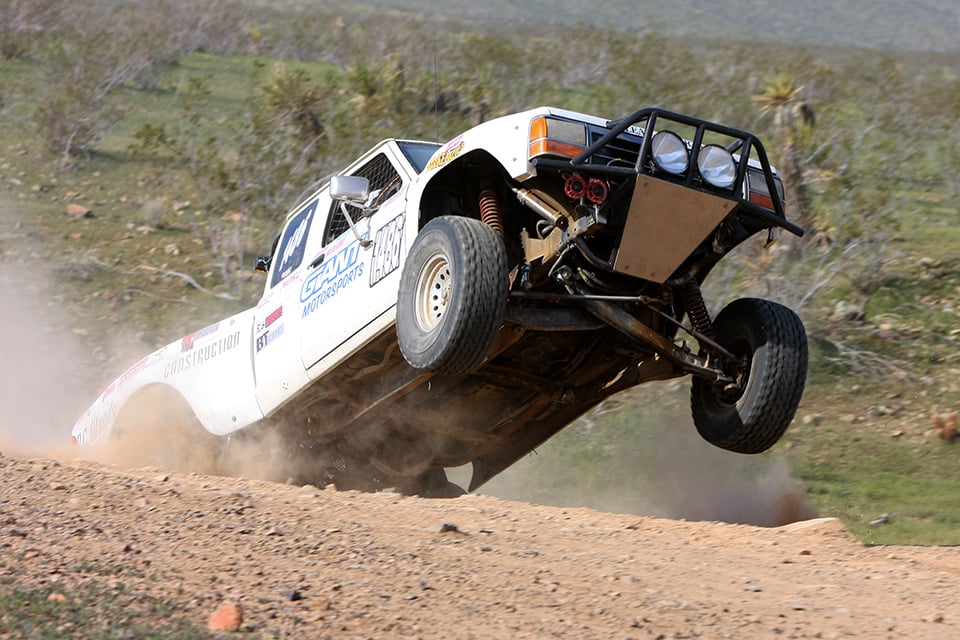
A 2WD Ford Ranger built by Behemothic Motorsports racing in a local event.
Slice Past Piece: Tires And Fiberglass
If you lot tin save your money and do it all at once, that's peachy, but nigh of you will need to build in stages. There is a popular saying that goes with automotive projects about a snowball rolling downhill, and it's true. As the snowball rolls downhill, information technology gets bigger and bigger. The same will be truthful with your build considering everything that you do affects everything else. Vehicles are engineered from the manufacturing plant to perform in a certain style and once you upset that, there are consequences.
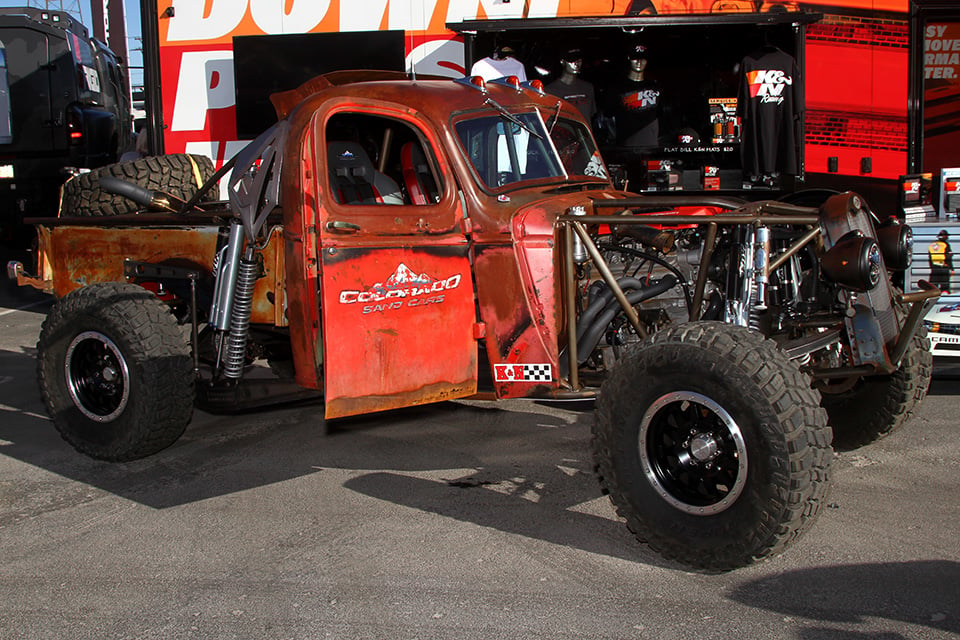
This early iron has snowballed into an amazing offroad truck.
The offset priority is tires. Your tires are the simply connection your vehicle has to the dirt. Good tires that are capable of taking some penalization from rocks, and other ecology factors are a must. You will have to assess the ratio of on-road to off-road travel you will exist doing. All-terrain tires perform better on pavement. More aggressive tread patterns perform better in the dirt, but might exist noisy on the pavement and grip less on moisture pavement due to the voids in the tread.
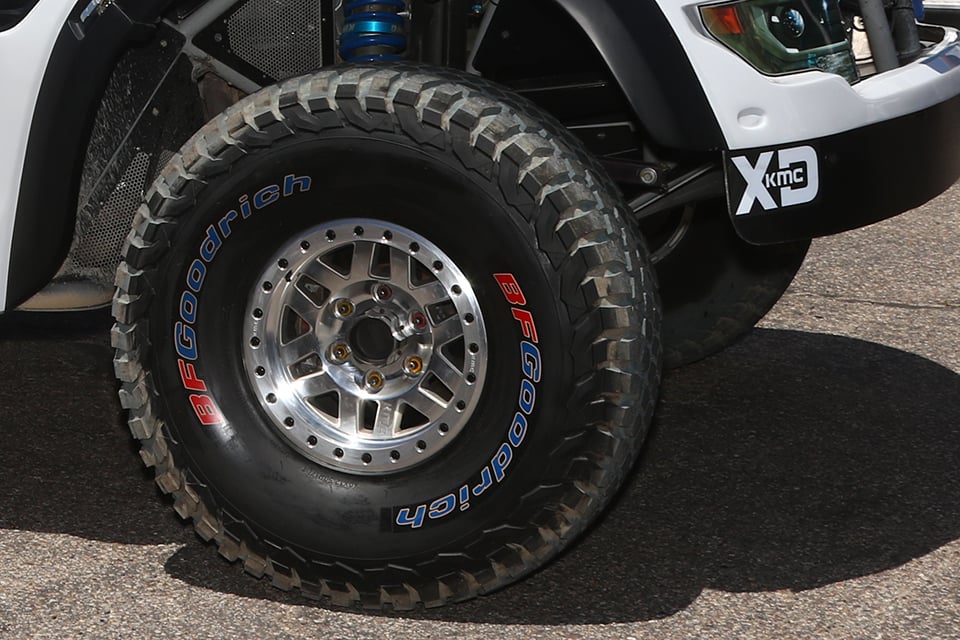
Here we see a Trophy Truck running 40-inch BF Goodrich tires, and KMC beadlock wheels.
What size tire will articulate the fenders, and how much the overall diameter will affect your gearing, will decide what size yous can run. The larger the diameter of the tire, the harder it is to commencement or stop. Increasing the diameter will likewise touch your turning radius. Nigh factory wheel openings are not very accommodating to bigger tires, and the rear typically has more than clearance than the forepart. "Self-clearancing" is bad for both the sail metal and your tires, then take the fourth dimension to practise some trimming before you feel harm.
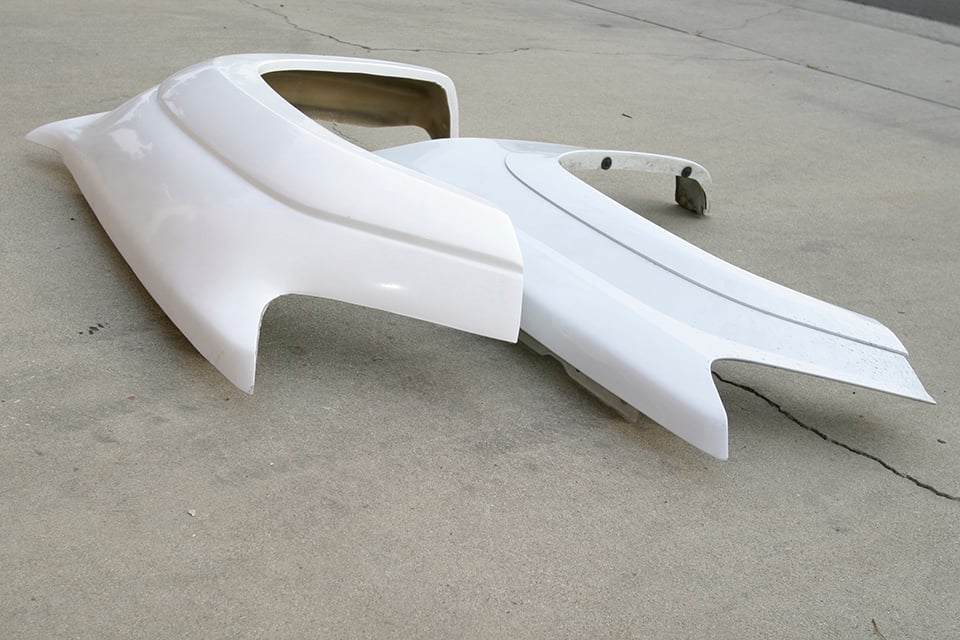
A factory Chevy Colorado fender (right) is dwarfed by a much wider fiberglass replacement (left).
If you lot are also upgrading the wheels, it'south important to go the offset and diameter right so you don't put undue stress on your wheel bearings, negatively affect your scrub radius, or create interference with your brake components. Bigger tires will increase your unsprung weight –the weight of your suspension components – so your stock shocks volition no longer exist upwards to the job.
Piece By Piece: Springs
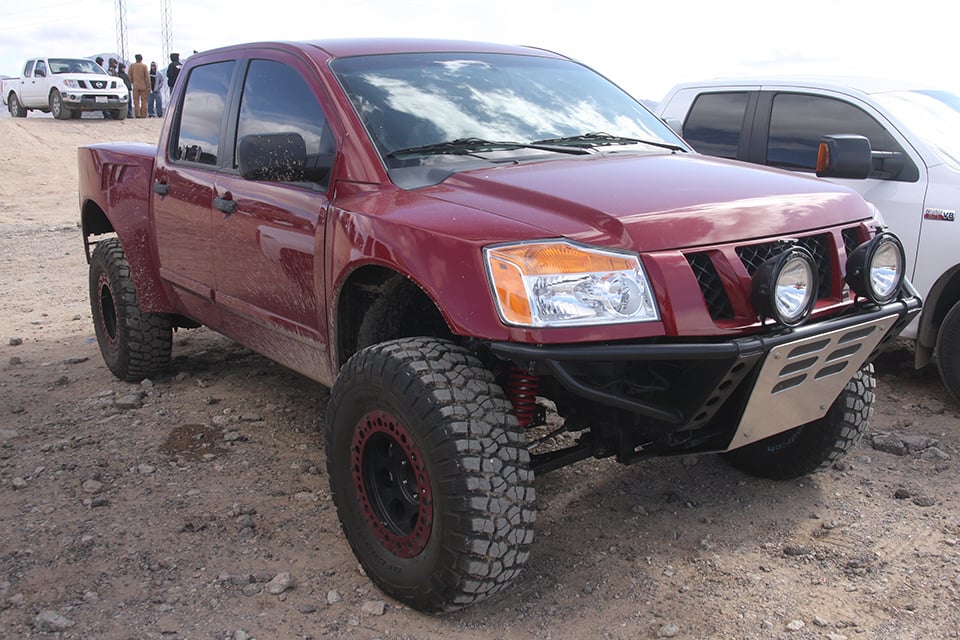
This Nissan prerunner has plenty of clearance around the tires.
Your project will ride on some type of springs whether they are coils, torsion confined, or leaves. Torsion bars and coils operate the same; leafage springs are unique.
Springs have a number of factors that make up one's mind their spring rate, which is the corporeality of force required to deflect a spring one inch. Standard coil springs have a linear jump charge per unit. That means if the leap rate is 500 pounds, it will take 500 pounds to compress it ane inch; 1000 pounds, to shrink it two inches, and then on. On the other hand, leaf springs have a progressive rate. As they compress, the spring rate increases. Leaf springs pull double duty by carrying the load and locating the beam. In rear truck applications, their progressive charge per unit works well – as y'all load cargo into the truck bed, the weight increases, compressing the springs. As that load compresses the springs farther, the leap charge per unit increases to compensate. The job of your springs, regardless of the type, is only to carry the load of your vehicle. Controlling the movement of the break falls on your shocks.
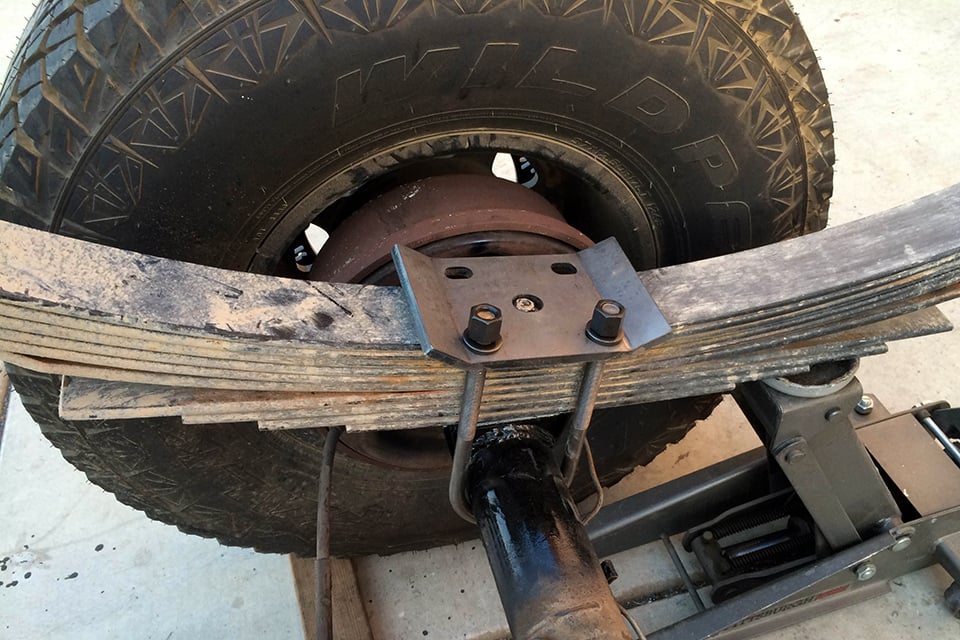
Atlas progressive leaf springs increase their bound rate as they compress.
Piece By Slice: Shocks
Thanks to racing, shock technology has reached a loftier level of sophistication. When y'all break information technology downwardly to basics, shocks dissipate kinetic energy by using friction to create heat. They are filled with thick oil that flows through orifices in the piston, and/or in featherbed openings. By controlling the menses of fluid, yous control the movement of the stupor. Shocks tin can as well exist used as a coil carrier to combine the bound and the daze together in a unmarried component. They are called coilover shocks.
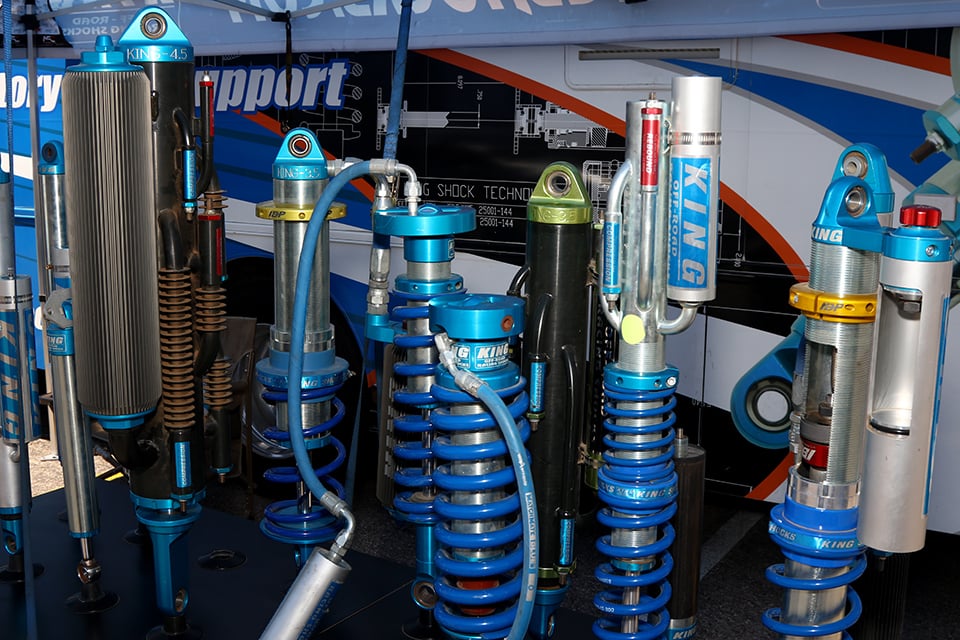
Shocks come in all shapes and sizes.
The other type of shock commonly used on prerunners is a bypass shock. A bypass daze has additional passageways for oil to flow through. Past changing the location of the bypass passage, you can command move in specific zones according to stupor shaft position. These shocks are known as position-sensitive shocks. The passageways can either be internal or external to the stupor trunk. To dingy things up, coilover shocks may likewise contain internal featherbed technology.
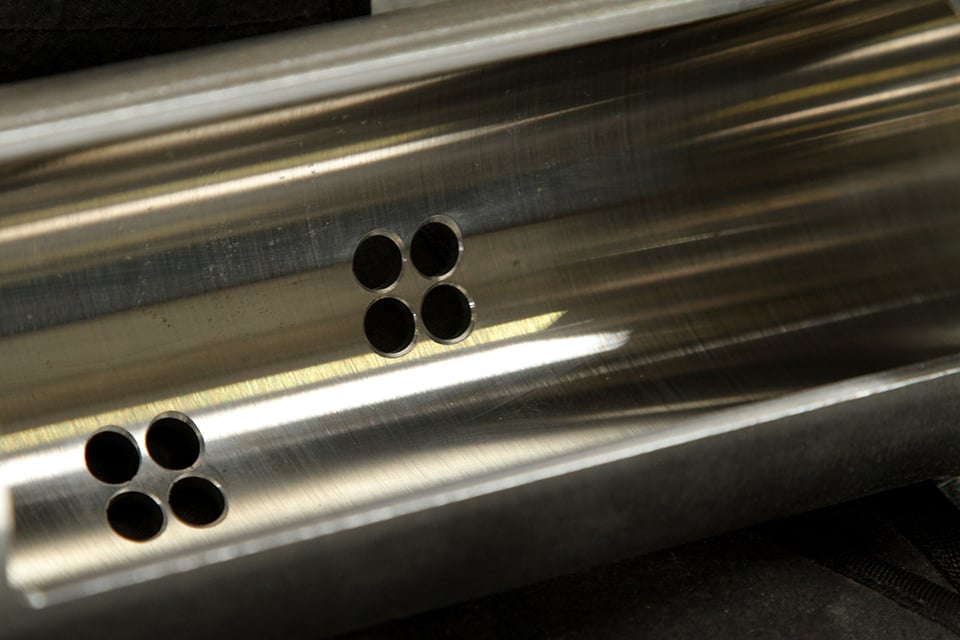
This cutaway shows the bypass openings in the daze body.
Shocks with external bypass tubes contain adjustable valves that allow yous to control the corporeality of fluid that flows through the passageway. Bypass tubes can control both the compression and rebound strokes of the stupor. This gives you an incredible amount of command.
Another form of daze aligning is the use of compression adjusters. These control the menstruum of fluid in and out of the reservoir. Reservoirs may be mounted to the shock body, or remotely. The reservoir has a floating, solid piston inside. A charge of nitrogen is introduced on one side of the piston to exert pressure on it, and hence the fluid. This prevents the fluid from mixing with any air, as air in the fluid reduces the effectiveness of the shock. Compressing the shock fluid will increase the point at which it volition boil; reducing daze fade. The reservoir gives the shock fluid room to expand when it gets hot, and contains the fluid that gets displaced by the daze shaft when the shock compresses. Slight adjustment to the shock valving is possible past irresolute the charge pressure in the reservoir.
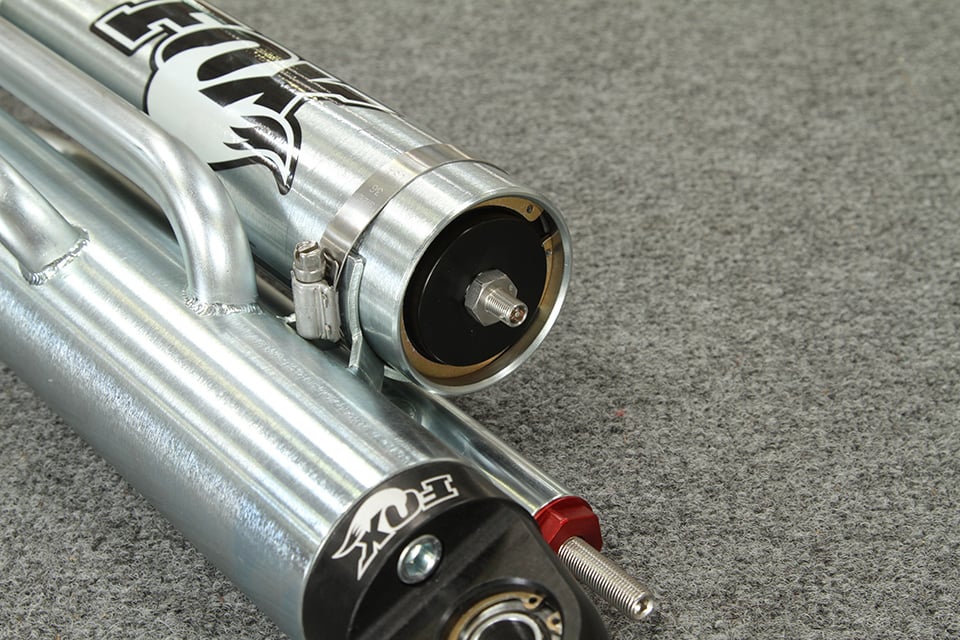
The Schrader valve on the finish of this Pull a fast one on reservoir is used to charge it with nitrogen.
Operation shocks tin also be taken apart for rebuilding or to modify the piston valving. The valving consists of shims that are made in varying thicknesses and diameters. The shims encompass ports in the piston, and flex open when the fluid is pushed through the ports. Performance shocks are synthetic from loftier-end materials to exacting dimensions. That'southward why they toll substantially more than than generic shocks. Since a prerunner'southward intermission is so important, expert shocks are crucial to the vehicle's performance.
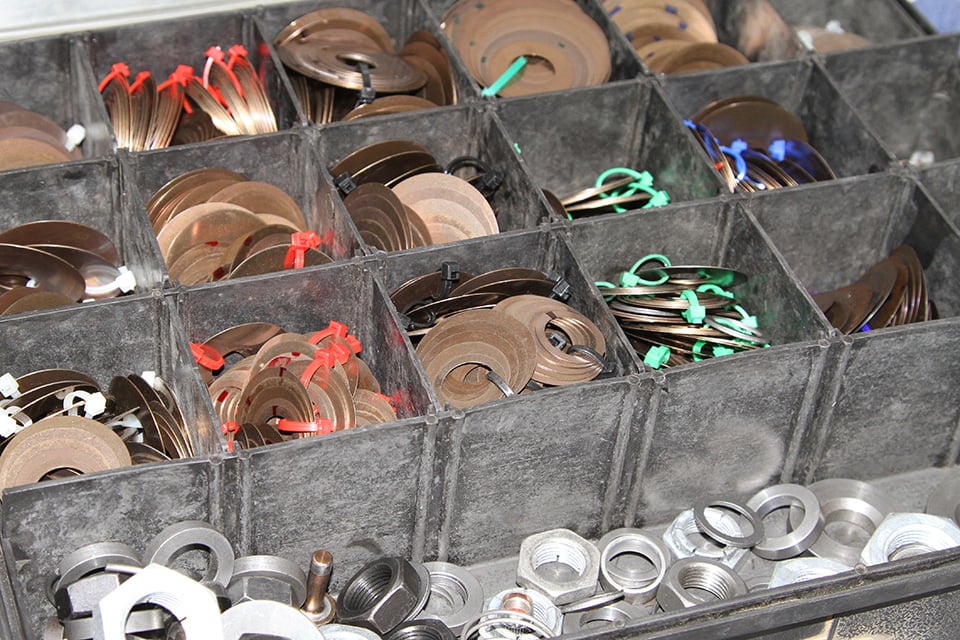
Shims used to adapt the internal stupor valving.
Thanks to the automotive aftermarket, there are many options bachelor that bolt directly to your truck's existing intermission mounts, meaning you tin feel enhanced suspension performance without doing whatever fabrication piece of work. Bilstein, Fob, King, and others have direct replacement shocks that are essentially improve than the manufactory offerings.
As an instance, Bilstein's ii.65-inch diameter B8 6112 has boosted oil capacity that helps cooling, increases damping potential, and provides long-term durability. Like many of the coilover factory replacement shocks, it bolts to the stock mounting associates and allows slight ride height adjustments to level the forepart end. Aftermarket bolt-on shocks are a elementary and effective fashion to get enhanced performance without sacrificing the factory ride.
With practiced tires, functioning shocks, and a traction assist like a limited-sideslip or locking differential, you'll now have a vehicle capable of getting effectually the desert – only you are probably still express to slower speeds. In society to reach the adjacent level of performance, you lot will have to take the adjacent step which entails cut into your cab, and doing custom fabrication. Stay tuned for part two of our series, where we will get over the next steps in prerunner builds – advanced prerunners.
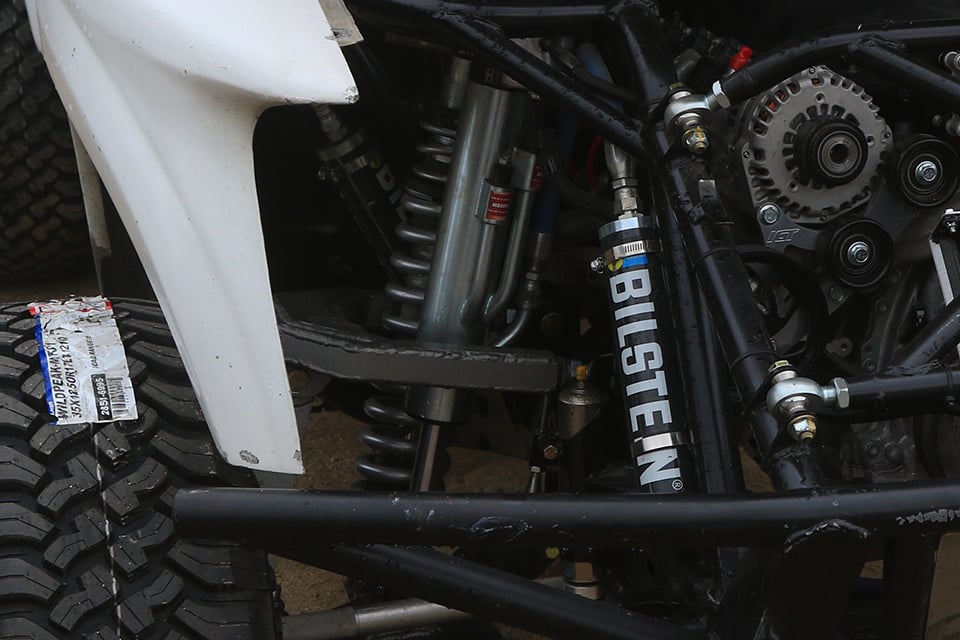
Bilstein has applications that range from bolt-on factory replacements to loftier- tech race shocks.
Source: https://www.offroadxtreme.com/features/car-features/prerunner-building-101-basics/

0 Response to "How To Build A Trophy Truck"
Post a Comment